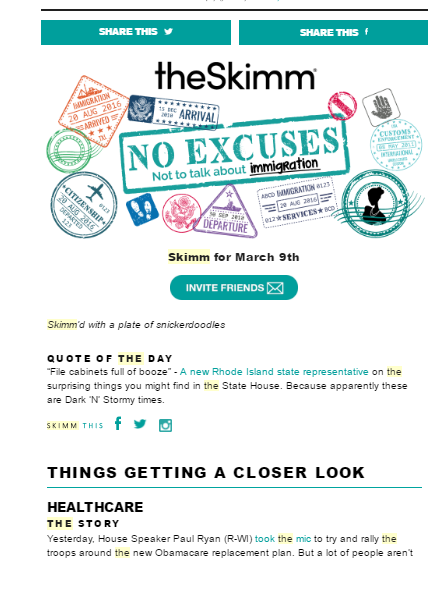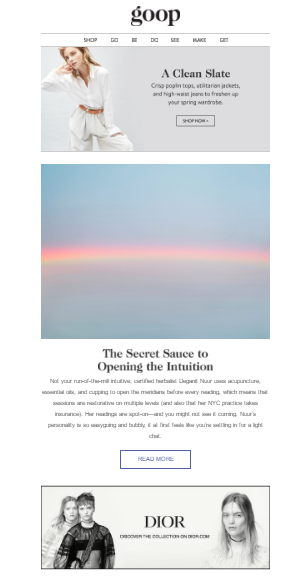If you’re searching for the most effective way to acquire customers or get them to love your brand, look no further than email newsletters. McKinsey research found that email is 40 times more effective than social campaigns for growing your business. Customers who purchase through your newsletter also spend 17 percent more than those who don’t.
How do you turn your email newsletter into something your customers love seeing hit their inbox, instead of sending them running for the nearest spam button or unsubscribe link? Here’s a look at four fantastic newsletters that are doing it right and what you can learn from their examples.
theSkimm
Every morning, theSkimm lands in inboxes around the globe and informs a horde of busy readers what topics dominated the headlines in the past 24 hours. From political scandals to big Hollywood announcements, theSkimm covers it all. The writing is exceptional, with quirky subheads, a millennial-friendly tone, and real insights that are couched in clever copy that’s a pleasure to read.
Get it: Write for a specific audience. From word choice and tone to small touches like the types of subheads you use (theSkimm example: " to Say to Your Friend Who’s Starting to Look for Her ‘Next Opportunity'") getting the details right helps content feel relevant, personalized, and interesting to your specific readers.
goop
The lifestyle brand of Gwyneth Paltrow, goop’s success is due to more than just star power. It’s strategy, with a newsletter that’s targeted to an audience of health and beauty conscious readers with a fair amount of disposable income. While I’m hardly up-to-date on the latest celebrity headlines, never mind business ventures, I look forward to this email every week for one reason: high-quality original content that’s targeted to my interests. For example, a recent article addressed effective non-toxic moisturizers for dry skin, and then it linked to related products. It’s a low pressure, high-value way of selling and it organically (get it?) guides readers on the path to purchase.
Key lesson: Create content that speaks to your customers’ interests, and use that as a way to guide them toward your products and services that provide a solution. Make buying the product the only logical call-to-action after they’ve read your newsletter because it spoke so specifically to their needs.
Industry Dive
Industry Dive has created a series of newsletters targeted to executives and professionals in different verticals, from healthcare to marketing. Each day, the newsletters contain a handful of the industries’ top headlines with analyses, along with occasional original reported pieces and interviews. These newsletters are a great example of how knowledge can set you apart—and curation is as much a viable strategy as creating original content.
Key lesson: Find your unique point of view on your industry or on the issues your readers care about. Consider developing round-ups of must-read news, and personalize it by adding your own analysis.
“Level Up” by Forbes
Forbes recently launched its “Level Up” newsletter, which they describe as “The newsletter delivering career tips, life hacks, and success stories.” Each issue features three or four topics and delivers highly actionable strategies in scannable and bullet point form. A recent edition offered tips on maximizing airline miles and credit card rewards, tips on how to write like Warren Buffet, using streaming services to workout on the road, and retirement tips. The packaging—which is incredibly digestible on mobile devices in just a few minutes—keeps me opening this one daily.
Key lesson: It’s not just what you say, it’s how you say it. Are your readers hungry for easy to skim actionable bullet points or thoughtful in-depth explorations on issues they care about? Crack the code on what your readers want in terms of packaging information—and what your competition isn’t delivering—and they’ll become dedicated readers.
Making the most of your e-mail newsletter
These newsletters—and those of other brands that get customers to subscribe and open again and again—have a few key lessons in common:
- They understand who their customer is and relentlessly provide customized and high-value content by getting the voice, content and design right.
- They package content in a way that’s highly digestible for their audience, whether it’s a quirky analysis of the headlines or making complex information mobile-friendly.
- They’re not afraid to sell in the context of solving their readers’ problems, but they do the work to really show they understand the problem and can offer a viable solution.
- They take advantage of automation tools to schedule content in advance, so they’re delivering consistently on a schedule that their audiences come to expect and trust.
So, are you ready to turbocharge your own email newsletter marketing? If so, Keap can help. The Keap app comes preloaded with an extensive library of flexible, functional email templates for a variety of opportunities.






